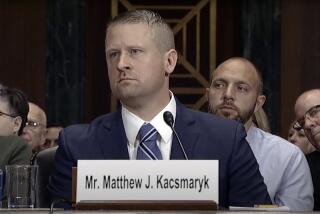The Peril of Avoiding Birth Control Issue
- Share via
They are gone now, the earnest faces of the retired and the devout. They are gone with their placards, from the front of the building where the school board sits. Their photographs have receded from the newspapers. They no longer occupy the auditorium on Normal Street, clutching their black and white signs.
The local Catholic bishop has made all his pronouncements on “parental control.”
The superintendent of schools has acknowledged defeat. He will not present the issue again. The battle is over. There will be no high school health clinics in San Diego.
Meanwhile, at a medical clinic in Imperial Beach, a 17-year-old boy presses his face against the glass partition separating him from the receptionist and yells to the nurse, “Ya got any condoms?” “One package or two?” the nurse calls out as she heads for the supply room. “Two” he answers with feigned machismo.
It is a late Friday afternoon at the San Diego Job Corps Center.
America’s history of the dissemination of birth control information has always been a troubled one. At the turn of the century, Margaret Sanger was repeatedly arrested and her clinics in the slums of New York closed. More recently, there have been bombings of women’s clinics by those opposed to abortion. Given this history, it is not surprising that there is such resistance to the concept of high school clinics.
However, there is such a clinic already in existence in San Diego. The federally funded Job Corps Center is a residential vocational training program for 600 youths between the ages of 16 and 24, who study everything from math and reading to auto mechanics and culinary arts. There is a medical clinic there that serves as the primary health care facility for all 600 residents. The clinic is heavily utilized by the students, with an average of 70 to 100 a day seeking medical advice for a wide variety of ailments. But it is undeniable that a preponderance of these young people come to the clinic for advice on sexual matters, treatment of sexually transmitted diseases and birth control information.
By the time these students enter the Job Corps, many have an established history of sexual activity, drug and alcohol abuse or a welfare dependency systemic of a one-parent home.
A great number of them were born to unwed teen-age mothers who did not know it would be so hard to raise them alone. Consequently, many of these Job Corps children found themselves unloved, resented and shoved aside until they, too, became teen-agers and were old enough to be shipped off into a federal training program to be taught manners, morals and a trade.
The nurse-practitioners who staff the clinic are dedicated and indefatigable in their efforts to turn this despairing tide. I talked with one of them at the end of a long day as she leaned wearily against a wall badly in need of paint. She spoke with frustration of the time consumed by bureaucratic inefficiencies and students who cavalierly missed medical appointments when they had serious cases of sexually transmitted diseases in need of immediate treatment. And then she said, “When I go home at night, I mentally review the day’s events. And if I kept one teen-age girl from getting pregnant, then my day was worthwhile.”
No close physical contact is allowed between male and female members at the Job Corps Center. If a young man is caught in a young woman’s room, it is grounds for immediate dismissal. And vice versa.
“Where do they go?” I asked another staff member.
“Well, the tennis courts at night are popular,” she said. “The parks, the beach, the shrubbery . . . almost any place will do in the dark.”
Another young woman who is 24 years old told me that she was madly in love with her new boyfriend because after she had sex with him for the first time, “he held me afterwards. No one else had ever done that before.” She had been sexually active for years.
The woman in the worn dress stopped me by a palm tree on Hawthorne Street and held out a piece of paper with an incorrect address on it. “Can you help us find this place?” said her young son. “It is a clinic for ladies.”
I pointed to an unassuming stucco building across the street. “Planned Parenthood?”
“Si,” she said with a broad smile. “Gracias.”
She took her son by the hand and crossed the street to the building, one of 40,000 people who will use the family planning services of Planned Parenthood this year. Of this number, more than 12,000 are teen-agers, according to Lenore Lowe, the Director of Community Affairs for the organization.
We were sitting in the well-stocked, heavily used library (which is open to the public) in Planned Parenthood’s administration building, and Lowe was speaking in soft measure of the aftermath of the school board’s decision to kill the proposal for a high school health clinic.
“The single most important issue was ignored,” she said. “And that is that teen-age girls have a high risk of giving birth to low birth-weight babies.” A low-birth-weight baby can mean an underdeveloped brain, heart or lungs; mental retardation, or death in infancy.
“The action by the school board flew in the face of information presented to them by established medical professionals in this community. With the information they now have regarding the high rates of teen-age suicide, depression, poor nutrition, alcohol and drug abuse and pregnancy, how can they remain silent? How can the school board possibly remain silent?”
We went on to speak of other things, but her question hung unanswered in the cool air of the room.
More to Read
Sign up for Essential California
The most important California stories and recommendations in your inbox every morning.
You may occasionally receive promotional content from the Los Angeles Times.













